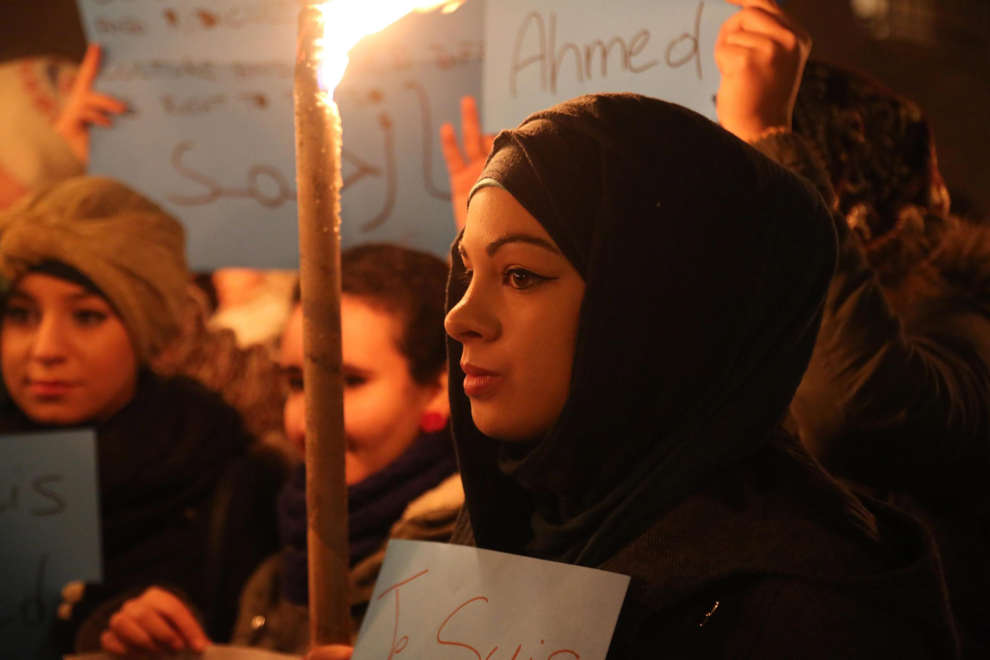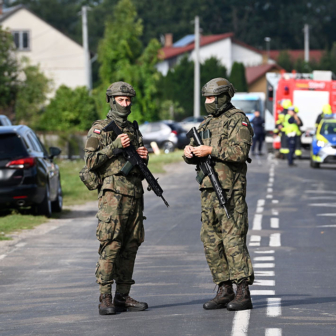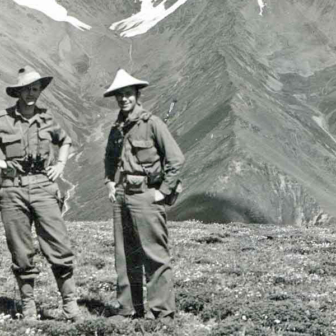The attack on the office of the Paris satirical weekly Charlie Hebdo seized our attention even as we are becoming accustomed to a seemingly never-ending series of terror stories. The worst terrorism attack in France in more than half a century was so audacious that it stopped us in our tracks in horror and in sympathy. Now that the initial shock is over, how should we respond?
In the hours following the attack, the prominent Somali-born American activist, commentator and former Dutch politician, Ayaan Hirsi Ali, wrote, “I’ve seen today the images of the sea of faces in European capitals holding placards, ‘I am Charlie Hebdo.’ That is beautiful and it’s the perfect thing to do.”
Ali is a provocative and outspoken commentator but most would agree with her about the Je Suis Charlie phenomenon. Most would also agree with her comments about the nature of the threat that we are facing. “We do need to wake up to the fact that there is a movement – a very lethal movement, very cruel – that has a political vision about how the world should be organised and how society should live,” she wrote. “And in order for them to realise their vision, they are willing to use any means. They are willing to use violence. They are willing to use terror.”
Where Ali becomes markedly more controversial is when she links the ideas behind jihadi terrorism to the teachings of Islam itself. On this point she has many admirers who will welcome her outspoken commentary. But others will question whether she is not being overly simplistic when she writes, “Is this some kind of cult? Or are the principles of this cult embedded in Islam? I happen to think they are embedded in Islam.”
Commentary in Australia over the past few days has reflected this divide. Many have spoken out in parallel with Ali, sheeting the problem home to Islam and, by implication, the Muslim community. Others have argued that this is exactly the response the terrorists are seeking to provoke.
What is at stake here is too important to be left either to esoteric debate or to dogma. How we respond, based on how we understand what is happening, will very much shape what happens after this. There are no simple ways of guaranteeing the safety of our society against the sort of attacks that we saw in Paris. But our attitudes and actions will very much play into how things develop.
Ali is correct in recognising the murderous nature of the determined political movements we are dealing with, and she is correct to acknowledge that they claim to act in the name of Islam regardless of whether most Muslims feel they have any right to do so.
Beyond those facts, the Lebanese-American academic and commentator Hussein Ibish has a different perspective from Ali’s. “The thugs who broke into the offices of the satirical French magazine Charlie Hebdo… and murdered twelve people in the name of God and religion no doubt imagined that they were ‘avenging blasphemy,’” he wrote. “But in reality, they committed an act of supreme blasphemy. They insulted, traduced, and denigrated the Prophet Muhammad, Islam, and Muslims the world over as effectively as possible.”
What are we really looking at? We now know quite a bit about the two gunmen, thirty-four-year-old Said Kouachi and thirty-two-year-old Cherif Kouachi. We also know quite a bit about their accomplice Amedy Coulibaly, also thirty-two, who stormed a kosher supermarket in the southeast of Paris (initially he was thought to be accompanied by his wife Hayat Boumeddiene, twenty-six) killing four and holding hostage more than a dozen customers as Said and Cherif were holed up northeast of Paris. Both Kouachi brothers were well-known to French authorities, and it’s been revealed that Said trained with al Qaeda in Yemen in 2011. What he did on Wednesday was fulfilment of an assassination call put out in March 2013 by al Qaeda in the Arabian Peninsula in its English-language magazine Inspire. Alongside the headline “Wanted Dead or Alive for Crimes against Islam” was a matrix of nine photos, one being of Stéphane Charbonnier – “Charb,” the editor of Charlie Hebdo – and the names of two women, one being Ayaan Hirsi Ali.
Cherif is even better known as an extremist with terrorist links. He was arrested in January 2005, charged with assisting to send French nationals to fight alongside al Qaeda in Iraq, and remained in detention until October 2006. Convicted in 2008, he was sentenced to three years’ jail with eighteen months suspended, sparing him further time in prison. It was during his time in jail that Cherif formed a friendship with Coulibaly. Over the past decade, Cherif showed unwavering commitment to the cause of al Qaeda. When he got out of prison he initially showed signs of returning to mainstream society, delivering pizzas and staffing a fish counter at a supermarket in a serious and focused way that impressed his manager. Nevertheless, his lawyer at the time told Le Parisien that he was “an apprentice ‘loser,’ a delivery boy in a ball cap who smoked hash and delivered pizzas to buy his drugs, a clueless kid who did not know what to do with his life, and overnight, met people who gave him the impression he was important.”
In 2010 the Kouachi brothers and Amedy Coulibaly were arrested for their part in a plot to break out of prison Algerian terrorist Smain Ait Ali Belkacem, who was serving a life sentence for his role in the 1995 train bombings in Paris that killed eight people. Coulibaly was sentenced to ten years but released early; the charges against the Kouachi brothers were dropped for lack of admissible evidence. The Kouachis, Coulibaly and Boumeddiene were all members of the Buttes Chaumont group, an extremist network meeting in the 19th arrondissement, the district on the northeast edge of Paris that is home to many immigrants from Algeria and Morocco. They were taught at the Addawa Mosque by the charismatic young preacher Farid Benyettou. For years the group had talked about attacking Jewish sites in Paris.
The story of the Kouachi brothers parallels that of the Tsarnaev brothers, who in April 2013 used instructions in Inspire to bomb the Boston Marathon. Their story also has much in common with those of other French nationals who have returned from fighting in the Middle East to conduct murderous attacks in Europe. In May last year Mehdi Nemmouche walked into a Jewish Museum in Brussels and opened fire with a Kalashnikov, shooting dead four people. The twenty-nine-year-old Algerian-French Nemmouche had just returned from fighting with jihadi militia in Syria. He was arrested at the Saint-Charles railway station in Marseille after a random security inspection found he was carrying the assault rifle wrapped in an ISIS flag, together with a .38 revolver, 330 rounds of ammunition, gun parts and a gas mask. He is thought to have been radicalised while serving a five-year prison sentence. Weeks after being released from prison in September 2012 he travelled to Syria to join with jihadi militants fighting the Assad regime.
Two years earlier, in March 2012, twenty-three-year-old Mohammed Merah went on a fortnight-long rampage in Toulouse and Montauban, shooting dead seven people before dying himself in a violent confrontation with police. Like Nemmouche, Merah was born in France of Algerian parents and was a disturbed young man with an extensive history of criminality and links with jihadi groups. In separate attacks on 11, 15 and 19 March, he shot dead three Jewish children, a rabbi and three French soldiers with a pistol. He, too, is believed to have become radicalised while serving time in prison. Security authorities recorded him making hundreds of phone calls to jihadi terrorists in North Africa and the Middle East and he is known to have trained with terrorists in Pakistan/Afghanistan and the Arab world.
These attacks are distinctly different in their mode and primary intention from other so-called loan wolf attacks we’ve seen around the world. They involved the cold, calculated, deadly use of military firearms by radicalised young men who had trained or fought with terrorists abroad, and they did not immediately seek the attention of the media. Sydney hostage-taker Man Haron Monis appears to have been motivated by a desire to secure media attention for himself and the Islamic State, or IS. Monis was evidently responding to a call from IS leaders to redeem himself by striking out against the “crusader coalition.” Imitating al Qaeda in the Arabian Peninsula, IS has published a slick, English-language online magazine. Dabiq, since July 2014; like Inspire, it has called on its readers to mount improvised attacks without wide consultation or elaborate plotting, using whatever weapons come to hand.
For their 15 April 2013 attack the Tsarnaev brothers used instructions in an Inspire article entitled “How to Make a Bomb in the Kitchen of Your Mom” to construct improvised explosive devices using domestic pressure cookers. Five weeks later twenty-eight-year-old Michael Adebolajo and twenty-two-year-old Michael Adebowale followed the script of another Inspire article when they ran down Fusilier Lee Rigby with their car, slit his throat with a kitchen knife and filmed their attack on a smart phone. Troubled youths born in London of African immigrant parents, the two Michaels had converted to extremist Islam after years of dissolute criminality. Adebolajo had been arrested by Kenyan authorities in 2010 and deported to Britain after being picked up on the suspicion that he was planning to train with the Somali al Qaeda affiliate, al Shabaab. He was associated with the notorious al Muhajiroun extremist group and with some of the same extremists Cherif Kouachi met during his time in London.
Just as the lives of these troubled men follow a similar pattern, so too does their attraction to the redemptive narrative of al Qaeda and Islamic State – the belief that by launching a terror attack they could, in effect, go from “zero to hero.” Their exploits have been recounted in Inspire and Dabiq, which declared that these “martyrs,” including Man Haron Monis, had wiped away their sins and found pleasure in the eyes of God and His people. Interestingly, Islamic State was quick to praise the actions of the Kouachi brothers; so too was al Qaeda in the Arab Peninsula, but it went further and claimed to have authored them.
A motive of seeking affirmation and redemption seems to lie behind the shooting of Corporal Nathan Cirillo by Michael Zehaf-Bibeau at the Canadian National War Memorial, across from the national parliament in Ottawa, on 22 October last year, and the killing two days earlier in Montreal of Warrant Officer Patrice Vincent by Muslim convert Martin Couture-Rouleau, who used his car to run down two uniformed soldiers.
One or more of three unrelated attacks in France late last month might have been motivated by a similar desire to act in the name of jihadi terrorism, although this is by no means as clear as the earlier cases. In Nantes and Dijon, drivers ran down pedestrians with their vehicles; in Tours, a recent convert to Islam attacked three police with a twelve-inch knife.
There are several disturbing new elements in the Paris shootings. First, they were of a scale never seen before. The biggest previous attack was led by Smain Ait Ali Belkacem in 1995 in the name of the Armed Islamic Group, an Islamist group seeking to overthrow the secular Algerian state, and targeted the French rail system, killing eight and wounding over one hundred. Three decades earlier, in June 1961, OAS, a radical French nationalist paramilitary group opposed to Algerian independence, bombed a Strasbourg–Paris express train, killing twenty-eight. For most of the postwar period terrorist attacks in France have been linked to the bloody dénouement of French colonialism in Algeria. Given the massive loss of life during the Algerian revolutionary struggle from 1954 to 1962 – numbers comparable to the present civil war in Syria – and the many more lives lost in the Algerian civil war from 1991 to 2002, it is, in many respects, a wonder that the impact on France has not been even greater.
The pattern we see with the Tsarnaev brothers and these young Frenchmen is disturbingly familiar and largely parallels patterns among Australians drawn to fight with IS. These young men, struggling with a sense of alienation and unable to find meaningful employment, have drifted into a life of petty crime and confrontation with police, been radicalised by charismatic mentors, and then travelled abroad to fight.
Ayaan Hirsi Ali’s friend, the Dutch politician Geert Wilders, and their French political associate Marine Le Pen vigorously assert that Islamist extremism and terrorism is innately linked to the teachings of Islam. Speaking in the wake of the attacks, French president François Hollande took the opposite position: “These fanatics, those terrorists, having nothing to do with Islam.”
The rhetoric of politicians, left or right, tends to be simplistic but the numbers support Hollande’s assertion. France has the largest Muslim population in Western Europe – around 9 per cent, or five to six million (census surveys do not document religious orientation) – and it has hundreds of thousands of young Muslims struggling to find satisfactory employment, many of whom report encountering prejudice and experiencing alienation. As many as 1000 young French nationals have left to join Islamic State, or al Qaeda affiliate Jabhat al-Nusra, in Syria and Iraq. Thousands more support jihadi groups in the Middle East and Northern Africa. These absolute numbers make the task of keeping extremists under surveillance very challenging. But they remain the fringe of the fringe, a small fraction of 1 per cent and not at all representative of France’s five million or more Muslims.
While the fear of Islam displayed by politicians of the far right is clearly excessive and prejudicial there is no escaping the fact that a small but significant minority of Muslims hold to a very toxic understanding of Islam. No religion or worldview is entirely free from a toxic fringe that clings parasitically to the mainstream and perverts its beliefs, but at this point in history it is a particularly virulent scourge in Muslim society. This is not the fault of ordinary Muslims. Nor is it their problem alone. If the events in Paris teach us anything, it is that we are all in this together. This is something that, together, we all have to deal with.
We have no simple answers to the threat posed by jihadi radicalisation and lone wolf terrorism. But we can choose how to respond. We can make it harder for the terrorists to achieve their ends, or we can react as they want us to and risk a cycle of recrimination that strengthens the extremist narrative – that turns losers into heroes – and robs us of the values that we have worked so hard to build. •




